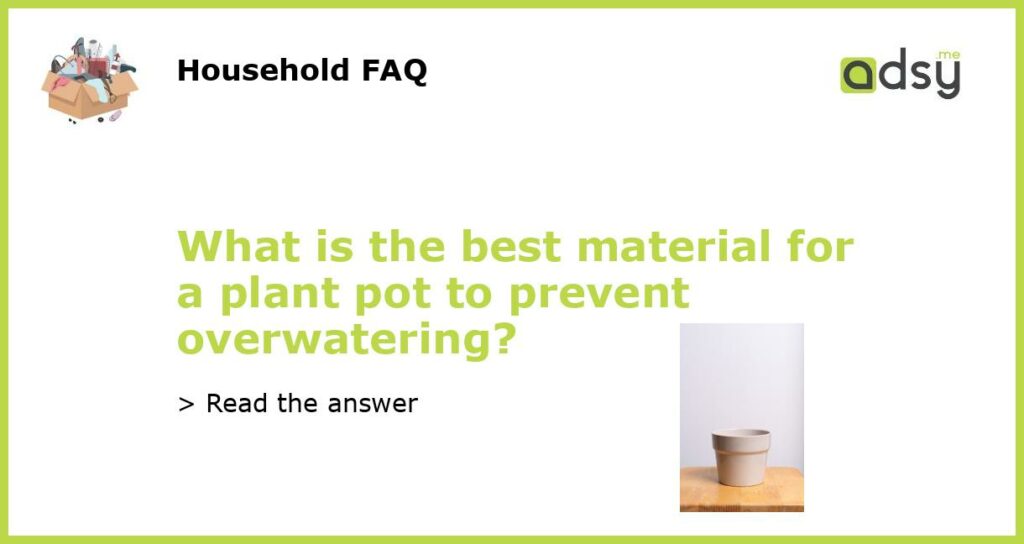Best Material for a Plant Pot to Prevent Overwatering
Overwatering is a common problem that can lead to root rot and the death of plants. To prevent this, selecting the right material for a plant pot is important. In this article, we will discuss the best material for a plant pot to prevent overwatering.
Terra Cotta Pots
Terra cotta pots have been popular for centuries due to their porous nature. The clay material allows for excess moisture to evaporate, preventing water from sitting at the bottom of the pot and causing root rot. This natural flow of air and moisture makes terra cotta pots an excellent choice for preventing overwatering. Additionally, the natural color and aesthetics of terra cotta pots can enhance the beauty of your plants and add a rustic touch to your garden.
However, it is important to note that terra cotta pots can also dry out quickly. The porous nature of the clay material means that the pot may absorb water from the soil, leading to faster evaporation. This makes it necessary to monitor the moisture levels of the soil more frequently and water the plant accordingly.
Fiberglass Pots
Fiberglass pots are another option to prevent overwatering. These pots are made with a mixture of fiberglass and resin, creating a lightweight and durable material. The non-porous nature of fiberglass prevents water from seeping through the pot, allowing for better control of moisture levels. The water stays in the soil, giving the plants access to it when needed. This material is especially useful for plants that require a more consistent level of moisture.
Furthermore, fiberglass pots offer a wide range of design options. They come in various colors, finishes, and sizes, making them a versatile choice for any garden or indoor space. The lightweight nature of fiberglass also makes it easier to move the pots around, especially for larger plants or gardens.
Plastic Pots
Plastic pots are a popular and affordable option for preventing overwatering. They are lightweight, durable, and do not absorb water. Plastic pots also retain moisture well and offer good drainage, which is important in preventing overwatering. These pots are available in a variety of sizes, shapes, and colors, making it easy to find the perfect option for your plants.
However, it is important to choose high-quality plastic pots made from food-grade plastic. Avoid using cheap plastic pots that may release harmful chemicals into the soil. Be sure to check for drainage holes as well, as they are crucial for preventing water buildup.
Self-Watering Pots
Self-watering pots are designed to prevent overwatering by providing a controlled water supply to plants. These pots typically consist of an outer container and an inner reservoir. The inner reservoir holds water, while a wick or capillary system delivers the water to the plant’s roots as needed.
Self-watering pots are available in various materials, including plastic, ceramic, and metal. They are a convenient option for busy individuals or for those who tend to overwater their plants. With a self-watering pot, you can ensure that your plants receive the right amount of moisture without the risk of overwatering.
Ceramic Pots
Ceramic pots are another suitable option for preventing overwatering. These pots are often glazed, creating a non-porous surface that retains moisture. Ceramic pots provide a stable environment for plants, allowing for better control of moisture levels. Additionally, ceramic pots come in a wide range of colors, shapes, and designs, making them a popular choice for indoor and outdoor spaces.
However, it is important to note that ceramic pots can be heavy, especially for larger plants. Make sure the pot is placed on a stable surface and consider using a plant caddy or stand to make movement easier.
When it comes to preventing overwatering, choosing the right material for a plant pot is crucial. Terra cotta pots, fiberglass pots, plastic pots, self-watering pots, and ceramic pots are all excellent options to avoid water buildup and promote healthy plant growth. Consider the specific needs of your plants, your gardening preferences, and the aesthetics you desire when selecting the best material for your plant pots.






